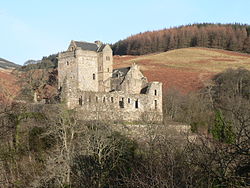Castle Campbell
| Castle Campbell | |
|---|---|
 |
|
| Coordinates | 56°10′29″N 3°40′29″W / 56.1748°N 3.6748°WCoordinates: 56°10′29″N 3°40′29″W / 56.1748°N 3.6748°W |
|
Listed Building – Category A
|
|
| Designated | 9 June 1960 |
| Reference no. | 1941 |
| Designated | 2007 |
Castle Campbell is a medieval castle situated above the town of Dollar, Clackmannanshire, in central Scotland. It was the lowland seat of the earls and dukes of Argyll, chiefs of Clan Campbell, from the 15th to the 19th century, and was visited by Mary, Queen of Scots, in the 16th century.
The castle was originally known as Castle Gloom, possibly deriving from the Scottish Gaelic: glom, meaning a chasm, and referring to the narrow gorges to either side of the site. The naturally defended position may have been the site of a motte in the 12th century. The present tower was built in around 1430 for John Stewart, Lord Lorn, (d.1463) or one of his kinsmen. In 1465 the property was acquired by Colin Campbell, 1st Earl of Argyll, (d.1493) on his marriage to Isabel, Lord Lorn's daughter. The first historical record of the castle dates from the following year, when Pope Paul II issued a bull against Walter Stewart, son of Lord Lorn, for attacking and damaging the "Place of Glowm". Argyll, who was at the papal court at the time, may have been instrumental in arranging the Pope's intervention. The tower shows signs of early rebuilding following this episode.
The acquisition of Gloom expanded the power of the Campbells from Argyll in the west into central Scotland, and suited his position as Master of the Household to James III, which required his frequent presence at court. In 1488 Argyll petitioned the newly crowned James IV to formally change the name of Gloom to Castle Campbell, and this was done by an act of parliament. The change in name may imply that the term "castle" was seen as particularly prestigious, requiring royal approval for its use. At this time, the castle would have comprised the tower house, with other buildings arranged around the courtyard, and gardens outside. The east range was probably added first, and some time after the accession of the 2nd Earl in 1493 the large south range was begun. This building shows the influence of the contemporary works at Stirling Castle, now known as the King's Old Building. It included a state apartment of hall, outer chamber and bedchamber, with large south-facing windows overlooking the gardens and the view across the Devon Valley. The range also provided additional private lodgings, and was accessed via two symmetrically placed stairways facing the courtyard.
...
Wikipedia

